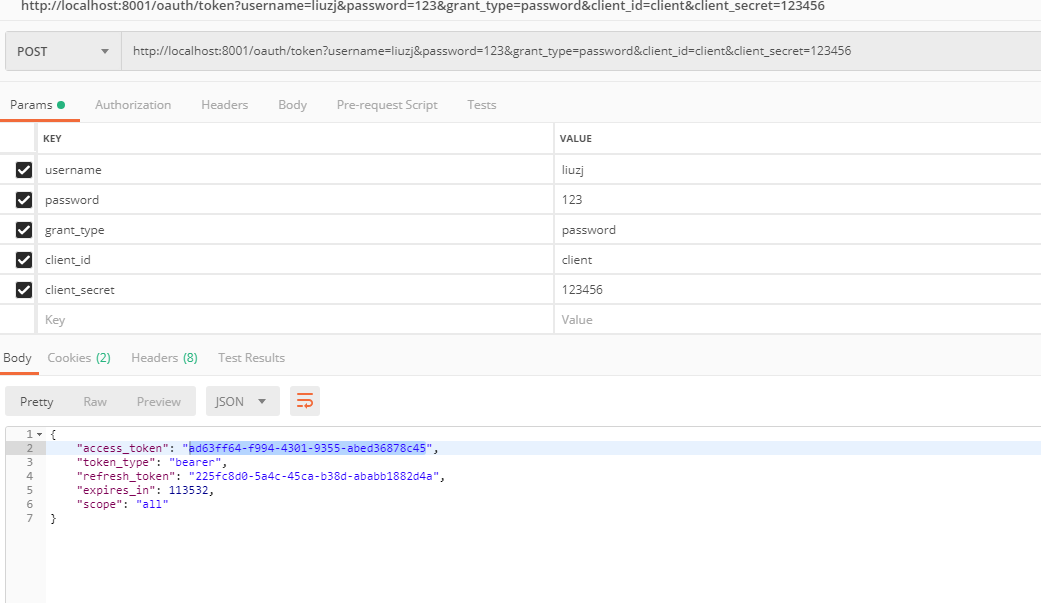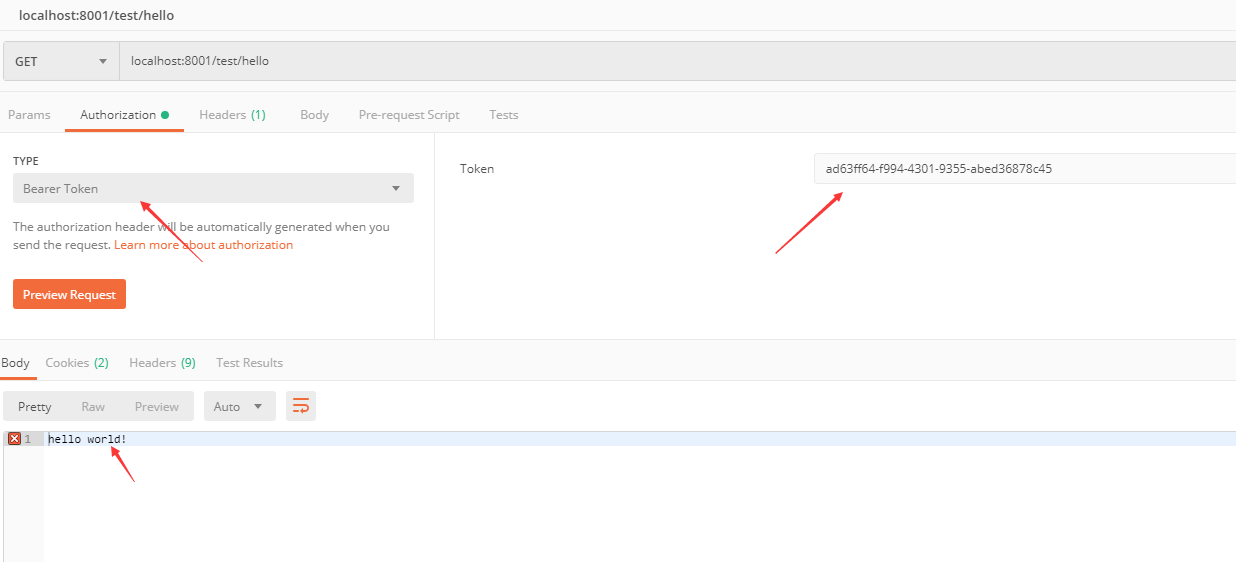Springboot2.0 + OAuth2.0之密码模式之单项目集成
概述:Spring OAuth2.0 是Spring Security中的模块,提供项目安全认证(包括身份,权限,角色认证等)。其作用和 shiro 差不多,同属于安全框架。但在使用角度个人觉得 shiro更易理解更易上手,更多差别还需了解。
其中OAuth2为我们提供了四种授权方式:
1、授权码模式(authorization code)
2、简化模式(implicit)
3、密码模式(resource owner password credentials)
4、客户端模式(client credentials)
而较常用的则为密码模式和授权码模式,而授权码模式又是最为安全的模式,复杂程度成正比。完整的项目结构分为:客户端服务,认证服务,资源服务。客户端需要访问资源服务的资源时,则需要得到认证服务的认证。
一、密码模式
(1)单项目集成(即认证服务即为资源服务)其项目结构如下:

此项目属于Maven项目。
• 配置认证服务器
首先需要配置认证服务所必须的配置,为 AuthorizationServerConfig 和 WebSecurityConfig 两个配置文件,其详情如下:
package com.liuzj.oauth2server.config; import org.springframework.beans.factory.annotation.Autowired; import org.springframework.beans.factory.annotation.Qualifier; import org.springframework.context.annotation.Bean; import org.springframework.context.annotation.Configuration; import org.springframework.context.annotation.Primary; import org.springframework.security.authentication.AuthenticationManager; import org.springframework.security.core.userdetails.UserDetailsService; import org.springframework.security.crypto.password.PasswordEncoder; import org.springframework.security.oauth2.config.annotation.configurers.ClientDetailsServiceConfigurer; import org.springframework.security.oauth2.config.annotation.web.configuration.AuthorizationServerConfigurerAdapter; import org.springframework.security.oauth2.config.annotation.web.configuration.EnableAuthorizationServer; import org.springframework.security.oauth2.config.annotation.web.configurers.AuthorizationServerEndpointsConfigurer; import org.springframework.security.oauth2.config.annotation.web.configurers.AuthorizationServerSecurityConfigurer; import org.springframework.security.oauth2.provider.ClientDetailsService; import org.springframework.security.oauth2.provider.client.JdbcClientDetailsService; import org.springframework.security.oauth2.provider.token.DefaultTokenServices; import org.springframework.security.oauth2.provider.token.TokenStore; import org.springframework.security.oauth2.provider.token.store.JdbcTokenStore; import javax.sql.DataSource; import java.util.concurrent.TimeUnit; /** * 这个注解告诉 Spring 这个应用是 OAuth2 的授权服务器, * 提供/oauth/authorize,/oauth/token,/oauth/check_token,/oauth/confirm_access,/oauth/error * * @author liuzj * @date 2019-01-15 */ @Configuration @EnableAuthorizationServer public class AuthorizationServerConfig extends AuthorizationServerConfigurerAdapter { /** * webSecurityConfig 中配置的AuthenticationManager */ @Autowired @Qualifier("authenticationManagerBean") private AuthenticationManager authenticationManager; /** * 此项目使用数据库保存 token 等信息所以要配置数据源 */ @Autowired private DataSource dataSource; /** * webSecurityConfig 中配置的 userDetailsService */ @Autowired @Qualifier("userDetailsServiceImpl") private UserDetailsService userDetailsService; /** * webSecurityConfig 中配置的 passwordEncoder(使用MD5加密) */ @Autowired PasswordEncoder passwordEncoder; @Bean public TokenStore tokenStore() { //使用内存中的 token store // return new InMemoryTokenStore(); //使用Jdbctoken store return new JdbcTokenStore(dataSource); } /** * 对 oauth_client_details 表的一些操作 * * @return ClientDetailsService */ @Bean public ClientDetailsService clientDetails() { return new JdbcClientDetailsService(dataSource); } @Autowired TokenStore tokenStore; @Autowired ClientDetailsService clientDetailsService; @Override public void configure(ClientDetailsServiceConfigurer clients) throws Exception { clients.jdbc(dataSource);
// 请求token的时候会将client_id,client_secret等信息保存到 oauth_client_details 表中,所以需要手动创建该表
// 注意:以下注释的代码在请求了一次 token 之后则可以注释掉,否则如果不换 client 名字的话会因为主键冲突无法插入 client 信息。也可以一开始就注释,手动添加记录到数据库 // .withClient("client") // .secret(passwordEncoder.encode("123456")) // .authorizedGrantTypes("authorization_code", "refresh_token", // "password", "implicit") // 四种认证模式 // .scopes("all") // .authorities("ROLE_admin","ROLE_user") // .redirectUris("http://www.baidu.com") // .accessTokenValiditySeconds(120000) // .refreshTokenValiditySeconds(50000); } @Override public void configure(AuthorizationServerSecurityConfigurer security) throws Exception { security.tokenKeyAccess("permitAll()") //允许check_token访问 .checkTokenAccess("permitAll()") //允许表单登录 .allowFormAuthenticationForClients(); } @Override public void configure(AuthorizationServerEndpointsConfigurer endpoints) throws Exception { endpoints.authenticationManager(authenticationManager); endpoints.tokenStore(tokenStore()); endpoints.userDetailsService(userDetailsService); endpoints.setClientDetailsService(clientDetailsService); //配置TokenServices参数 DefaultTokenServices tokenServices = new DefaultTokenServices(); tokenServices.setTokenStore(endpoints.getTokenStore()); tokenServices.setSupportRefreshToken(true); tokenServices.setClientDetailsService(endpoints.getClientDetailsService()); tokenServices.setTokenEnhancer(endpoints.getTokenEnhancer()); // access_token 过期时间:5s tokenServices.setAccessTokenValiditySeconds((int) TimeUnit.DAYS.toSeconds(1)); // refresh_token 过期时间,默认不过期 // tokenServices.setReuseRefreshToken(true); // tokenServices.setRefreshTokenValiditySeconds((int) TimeUnit.SECONDS.toSeconds(20)); endpoints.tokenServices(tokenServices); } @Bean @Primary public DefaultTokenServices tokenServices() { DefaultTokenServices tokenServices = new DefaultTokenServices(); tokenServices.setSupportRefreshToken(true); tokenServices.setTokenStore(tokenStore); return tokenServices; } }
package com.liuzj.oauth2server.config; import com.liuzj.oauth2server.utils.MD5Util; import org.springframework.beans.factory.annotation.Autowired; import org.springframework.beans.factory.annotation.Qualifier; import org.springframework.context.annotation.Bean; import org.springframework.context.annotation.Configuration; import org.springframework.security.authentication.AuthenticationManager; import org.springframework.security.config.annotation.authentication.builders.AuthenticationManagerBuilder; import org.springframework.security.config.annotation.web.builders.HttpSecurity; import org.springframework.security.config.annotation.web.configuration.EnableWebSecurity; import org.springframework.security.config.annotation.web.configuration.WebSecurityConfigurerAdapter; import org.springframework.security.core.userdetails.UserDetailsService; import org.springframework.security.crypto.password.PasswordEncoder; /** * 安全配置 * * @author liuzj * @date 2019-01-15 */ @Configuration @EnableWebSecurity public class WebSecurityConfig extends WebSecurityConfigurerAdapter { /** * userDetailsService 获取token的时候对用户进行一些自定义过滤,并将保存用户信息(用户名,密码,角色等) */ @Autowired @Qualifier("userDetailsServiceImpl") private UserDetailsService userDetailsService; /** * 使用MD5对client_secreat进行加密,可以使用默认的加密方式也可以自定义,这里使用MD5加密方式 * * @return PasswordEncoder */ @Bean public PasswordEncoder passwordEncoder() { return new PasswordEncoder() { @Override public String encode(CharSequence charSequence) { return MD5Util.encodeMD5(String.valueOf(charSequence)); } @Override public boolean matches(CharSequence charSequence, String s) { return s.equals(MD5Util.encodeMD5(String.valueOf(charSequence))); } }; } @Override @Bean public AuthenticationManager authenticationManagerBean() throws Exception { return super.authenticationManagerBean(); } /** * 配置用户签名服务 主要是user-details 机制, * * @param auth 签名管理器构造器,用于构建用户具体权限控制 * @throws Exception */ @Override protected void configure(AuthenticationManagerBuilder auth) throws Exception { auth.userDetailsService(userDetailsService) .passwordEncoder(passwordEncoder()); } @Override public void configure(HttpSecurity http) throws Exception { http.csrf().disable(); http .requestMatchers().antMatchers("/oauth/**","/login/**","/logout/**") .and() .authorizeRequests() .antMatchers("/oauth/**").authenticated() .and() .formLogin().permitAll(); //新增login form支持用户登录及授权 } }
以上有一个 UserDetailsService 这个接口是提供出来我们自己实现的,在实现代码中可以自定义一下过滤规则,比如判断用户的合法性,具体如下:
package com.liuzj.oauth2server.config.selfauthor; import com.liuzj.oauth2server.domain.User; import com.liuzj.oauth2server.repositories.UserRepository; import com.liuzj.oauth2server.utils.MD5Util; import org.apache.commons.logging.Log; import org.apache.commons.logging.LogFactory; import org.springframework.beans.factory.annotation.Autowired; import org.springframework.security.core.userdetails.UserDetails; import org.springframework.security.core.userdetails.UserDetailsService; import org.springframework.security.core.userdetails.UsernameNotFoundException; import org.springframework.stereotype.Service; /** * 进行登录用户自定义过滤 * * @author liuzj * @date 2019-01-15 */ @Service public class UserDetailsServiceImpl implements UserDetailsService { protected final Log logger = LogFactory.getLog(getClass()); @Autowired private UserRepository userRepository; @Override public UserDetails loadUserByUsername(final String username) throws UsernameNotFoundException { User user = userRepository.findByUserName(username); logger.info("loadUserByUsername username=" + username); // 如果用户不存在则认证失败 if(user == null){ throw new UsernameNotFoundException(username + " not found"); } // 注意:此处的密码记得要进行加密,因为在前面配置的时候是使用了 MD5 加密,所以这里也要进行加密 return new UserInfo(username, MD5Util.encodeMD5(user.getPassword()),user.getRole()); } }
以上只是将主要的配置附上,还有 user 表以及 集成 mybatis 等步骤没有写出,请自行倒腾。。。注意:user 对象需要实现 Serializable 接口(可序列化),因为在认证的时候该对象是需要进行IO操作的。
配置好认证服务之后跑如下 SQL 创建几张必须的表(存储 token 以及 client 等信息),因为本案例是使用数据库存储 token 的,当然也可以存在内存以及通过 jwt 方式:
-- ---------------------------- -- Table structure for oauth_access_token -- ---------------------------- DROP TABLE IF EXISTS `oauth_access_token`; CREATE TABLE `oauth_access_token` ( `token_id` varchar(256) CHARACTER SET utf8 COLLATE utf8_general_ci NULL DEFAULT NULL, `token` blob NULL, `authentication_id` varchar(250) CHARACTER SET utf8 COLLATE utf8_general_ci NOT NULL, `user_name` varchar(256) CHARACTER SET utf8 COLLATE utf8_general_ci NULL DEFAULT NULL, `client_id` varchar(256) CHARACTER SET utf8 COLLATE utf8_general_ci NULL DEFAULT NULL, `authentication` blob NULL, `refresh_token` varchar(256) CHARACTER SET utf8 COLLATE utf8_general_ci NULL DEFAULT NULL, PRIMARY KEY (`authentication_id`) USING BTREE ) ENGINE = InnoDB CHARACTER SET = utf8 COLLATE = utf8_general_ci ROW_FORMAT = Dynamic; -- ---------------------------- -- Table structure for oauth_client_details -- ---------------------------- DROP TABLE IF EXISTS `oauth_client_details`; CREATE TABLE `oauth_client_details` ( `client_id` varchar(250) CHARACTER SET utf8 COLLATE utf8_general_ci NOT NULL, `resource_ids` varchar(256) CHARACTER SET utf8 COLLATE utf8_general_ci NULL DEFAULT NULL, `client_secret` varchar(256) CHARACTER SET utf8 COLLATE utf8_general_ci NULL DEFAULT NULL, `scope` varchar(256) CHARACTER SET utf8 COLLATE utf8_general_ci NULL DEFAULT NULL, `authorized_grant_types` varchar(256) CHARACTER SET utf8 COLLATE utf8_general_ci NULL DEFAULT NULL, `web_server_redirect_uri` varchar(256) CHARACTER SET utf8 COLLATE utf8_general_ci NULL DEFAULT NULL, `authorities` varchar(256) CHARACTER SET utf8 COLLATE utf8_general_ci NULL DEFAULT NULL, `access_token_validity` int(11) NULL DEFAULT NULL, `refresh_token_validity` int(11) NULL DEFAULT NULL, `additional_information` varchar(4096) CHARACTER SET utf8 COLLATE utf8_general_ci NULL DEFAULT NULL, `autoapprove` varchar(256) CHARACTER SET utf8 COLLATE utf8_general_ci NULL DEFAULT NULL, PRIMARY KEY (`client_id`) USING BTREE ) ENGINE = InnoDB CHARACTER SET = utf8 COLLATE = utf8_general_ci ROW_FORMAT = Dynamic; -- ---------------------------- -- Table structure for oauth_refresh_token -- ---------------------------- DROP TABLE IF EXISTS `oauth_refresh_token`; CREATE TABLE `oauth_refresh_token` ( `token_id` varchar(256) CHARACTER SET utf8 COLLATE utf8_general_ci NULL DEFAULT NULL, `token` blob NULL, `authentication` blob NULL ) ENGINE = InnoDB CHARACTER SET = utf8 COLLATE = utf8_general_ci ROW_FORMAT = Dynamic;
-- ---------------------------- -- Table structure for user -- ----------------------------
CREATE TABLE `user` (
`id` int(11) NOT NULL AUTO_INCREMENT COMMENT '用户ID',
`name` varchar(255) NOT NULL DEFAULT '' COMMENT '名称',
`password` varchar(255) NOT NULL DEFAULT '0' COMMENT '密码',
`role` varchar(255) NOT NULL COMMENT '角色',
PRIMARY KEY (`id`)
) ENGINE=MyISAM AUTO_INCREMENT=5 DEFAULT CHARSET=utf8;
到此,启动项目,访问连接:http://localhost:8001/oauth/token?username=liuzj&password=123&grant_type=password&client_id=client&client_secret=123456 (POST)
正常情况下如下返回:

这样就成功通过 账号和密码获取了 token。还可以尝试如下操作:
检查 token :http://localhost:8001/oauth/check_token?token=f0cb83c3-6dd7-4c63-ab9f-2bdf3d492b46 (get)
刷新 token: http://localhost:8001/oauth/token?grant_type=refresh_token&refresh_token=cd08de58-b91f-45c6-b165-6b8bd4b7bfdc&client_id=client&client_secret=123456 (post)
• 配置资源服务器
首先配置资源服务器专有配置,如下:
package com.liuzj.oauth2server.config; import org.springframework.context.annotation.Configuration; import org.springframework.security.config.annotation.web.builders.HttpSecurity; import org.springframework.security.oauth2.config.annotation.web.configuration.EnableResourceServer; import org.springframework.security.oauth2.config.annotation.web.configuration.ResourceServerConfigurerAdapter; /** * 这个类表明了此应用是OAuth2 的资源服务器,此处主要指定受资源服务器保护的资源链接 * 默认情况下spring security oauth2的http配置会被WebSecurityConfigurerAdapter的配置覆盖 * * @author liuzj * @date 2019-01-15 */ @Configuration @EnableResourceServer public class ResourceServerConfig extends ResourceServerConfigurerAdapter { @Override public void configure(HttpSecurity http) throws Exception { http.csrf().disable()//禁用了csrf(跨站请求伪造)功能 .authorizeRequests()//限定签名成功的请求 //必须认证过后才可以访问;注意:hasAnyRole 会默认加上ROLE_前缀,而hasAuthority不会加前缀 .antMatchers("/decision/**","/govern/**").hasAnyRole("user") // 在角色过滤的时候需要注意user角色需要加角色前缀 .antMatchers("/admin/**").hasRole("admin") .antMatchers("/test/**").authenticated() // 免验证请求 .antMatchers("/oauth/**").permitAll(); } }
配置好如上配置就搞定了。重启项目测试访问项目接口(接口自行去码):

如果直接访问它便会提示:此资源访问需要认证。所以得先获取 token(上面有讲)带上 token 即可访问接口,如下:


到此密码认证告一段落。

